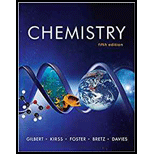
Concept explainers
Interpretation: The reason corresponding to the fact that temperature, at which the process of denaturation occurs, if the salt concentration of the given solution is increased, is to be suggested.
Concept introduction: DNA stands for deoxyribonucleic acid. It is highly charged polyanion. The structure of DNA is double helix which is given by famous scientists James Watson and Francis Crick. Two
Denaturation is a process in which, if solution of DNA is heated, it separates into individual strands.
To determine: The reason corresponding to the fact that temperature, at which the process of denaturation occurs, if the salt concentration of the given solution is increased.
Want to see the full answer?
Check out a sample textbook solution
Chapter 20 Solutions
CHEMISTRY:SCI.IN CONTEXT (CL)-PACKAGE
- Metal clusters and catalysis.arrow_forwardQ1: Draw a valid Lewis structures for the following molecules. Include appropriate charges and lone pair electrons. If there is more than one Lewis structure available, draw the best structure. NH3 Sulfate Boron tetrahydride. C3H8 (linear isomer) OCN NO3 CH3CN SO2Cl2 CH3OH2*arrow_forwardIn the following molecule, indicate the hybridization and shape of the indicated atoms. -z: CH3 CH3 H3C HO: CI: :arrow_forward
- Q3: Draw the Lewis structures for nitromethane (CH3NO2) and methyl nitrite (CH3ONO). Draw at least two resonance forms for each. Determine which form for each is the major resonance contributor. Page 1 of 4 Chem 0310 Organic Chemistry 1 Recitations Q4: Draw the Lewis structures for the cyanate ion (OCN) and the fulminate ion (CNO-). Draw all possible resonance structures for each. Determine which form for each is the major resonance contributor.arrow_forwardMetallic clusters and nanomaterials.arrow_forwardMetal clusters: photochemical properties of special relevance in solar energy conversionarrow_forward
- Q2: Draw all applicable resonance forms for the acetate ion CH3COO. Clearly show all lone pairs, charges, and arrow formalism.arrow_forwardIndicate what metal clusters are.arrow_forward55. The photoelectric threshold energy for ytterbium metal is 4.16 × 10-19 J/atom. a. Calculate the wavelength of light that this energy corresponds to (in nm). b. Which region of the electromagnetic spectrum does this wavelength fall in? c. Would light of wavelength 490 nm produce a photoelectric effect in ytterbium? Why or why not?arrow_forward
 ChemistryChemistryISBN:9781305957404Author:Steven S. Zumdahl, Susan A. Zumdahl, Donald J. DeCostePublisher:Cengage Learning
ChemistryChemistryISBN:9781305957404Author:Steven S. Zumdahl, Susan A. Zumdahl, Donald J. DeCostePublisher:Cengage Learning ChemistryChemistryISBN:9781259911156Author:Raymond Chang Dr., Jason Overby ProfessorPublisher:McGraw-Hill Education
ChemistryChemistryISBN:9781259911156Author:Raymond Chang Dr., Jason Overby ProfessorPublisher:McGraw-Hill Education Principles of Instrumental AnalysisChemistryISBN:9781305577213Author:Douglas A. Skoog, F. James Holler, Stanley R. CrouchPublisher:Cengage Learning
Principles of Instrumental AnalysisChemistryISBN:9781305577213Author:Douglas A. Skoog, F. James Holler, Stanley R. CrouchPublisher:Cengage Learning Organic ChemistryChemistryISBN:9780078021558Author:Janice Gorzynski Smith Dr.Publisher:McGraw-Hill Education
Organic ChemistryChemistryISBN:9780078021558Author:Janice Gorzynski Smith Dr.Publisher:McGraw-Hill Education Chemistry: Principles and ReactionsChemistryISBN:9781305079373Author:William L. Masterton, Cecile N. HurleyPublisher:Cengage Learning
Chemistry: Principles and ReactionsChemistryISBN:9781305079373Author:William L. Masterton, Cecile N. HurleyPublisher:Cengage Learning Elementary Principles of Chemical Processes, Bind...ChemistryISBN:9781118431221Author:Richard M. Felder, Ronald W. Rousseau, Lisa G. BullardPublisher:WILEY
Elementary Principles of Chemical Processes, Bind...ChemistryISBN:9781118431221Author:Richard M. Felder, Ronald W. Rousseau, Lisa G. BullardPublisher:WILEY





